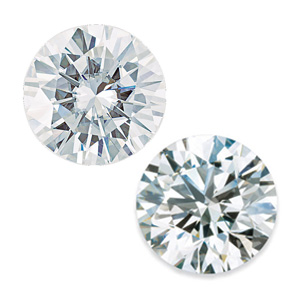For those looking for a more affordable alternative to a diamond, moissanite is an excellent option. Here’s everything you need to know about this gemstone and how it compares to a diamond.
Moissanite, or silicon carbide, is a very rare mineral that comes from space in the form of meteorites. The gem is named after the French chemist who discovered it, Dr. Henri Moissan. Since natural moissanite is so rare and small in size, chances are you’ll never see it set in jewelry. Instead, the moissanite you’ll find in jewelry today is actually lab-created by a company called Charles & Colvard, who began manufacturing the gemstone in the late 1990s. With an appearance very similar to that of a diamond, moissanite is often confused with the precious gem, but it’s important to note that these are two separate gemstones. When deciding which one is the best fit for you, keep these points in mind.
Durability: You won’t find a gemstone harder than a diamond, which comes in at 10 on the Mohs Scale of Mineral Hardness. But moissanite does come relatively close with a hardness rating of 9.25. So what does this mean for the average jewelry consumer? Both moissanite and diamonds are excellent choices for gemstones that are going to be able to stand up to everyday wear, but diamonds will be the most durable.
Brilliance: When you think of gemstones that offer a lot of sparkle, chances are diamonds are one of the first gems that pop into mind. But believe it or not, moissanite actually offers more brilliance compared to a diamond. Ranging from 2.65 to 2.69 on the refractive scale, lab created moissanite actually has a higher refractive index than diamonds (2.42).
Color reflection: Moissanite will emit more colorful flashes of light compared to a diamond. Some people feel this makes the gemstone appear fake while others appreciate the added effect.
Sourcing: As stated before, moissanite is created in a lab. Diamonds, on the other hand, can either be created or mined from the earth. If you’d prefer a genuine gemstone over a created one, go with a natural diamond.
Grading: If you’re looking to purchase a diamond, chances are you’re familiar with the Gemological Institute of America (GIA), the world’s foremost authority on diamonds. They invented the international diamond grading system (commonly known as the 4 C’s) that the jewelry industry uses for evaluating diamond quality. By looking at a diamond’s carat weight, cut, clarity, and color grade on its GIA certificate, you can get a better sense of whether the diamond you’re getting is worth the money you’re paying for it. Moissanite, on the other hand, is not graded by the GIA, so value is a bit more challenging to determine. Overall though, here’s what you can expect in regards to a moissanite’s clarity, color, cut, and carat weight:
- Clarity: Most gemstone professionals agree that the clarity of a moissanite is equivalent to a rating of VS on a natural diamond. This means that the inclusions shouldn’t be visible to the naked eye.
- Color: Unlike the GIA color grading system used on diamonds, which has twenty-three different color grades, moissanite can be categorized into one of three color grades: colorless (comparable to a D, E, or F GIA certified diamond), near-colorless (G, H, or I), and faint hues of color (J or K).
- Cut: Moissanite is cut to maximize the brilliance of the gemstone.
- Carat Weight: Whereas diamonds are sold by carat weight, moissanite is sold by millimeter size. This is because moissanite weighs about 10% less than diamonds. So a 6.5mm diamond would weigh around 1 carat and a 6.5mm moissanite would weigh about 0.88 carat.
Price: Moissanite is a fraction of the cost of a diamond. It offers individuals who aren’t able to afford an actual diamond the opportunity to get a gemstone similar in appearance to a diamond but at a much lower cost. But there’s a reason why diamonds remain to be the number one choice for colorless gemstones found in engagement rings and other fine jewelry. There’s a certain significance and prestige that comes with owning or receiving a piece of diamond jewelry, one that cannot be replicated by any other gemstone.
If you’re interested in purchasing your own moissanite or diamond jewelry piece, contact Kloiber Jewelers at 414-276-2457 or info@kloiberjewelers.com and we’d be happy to help answer any additional questions you may have.


